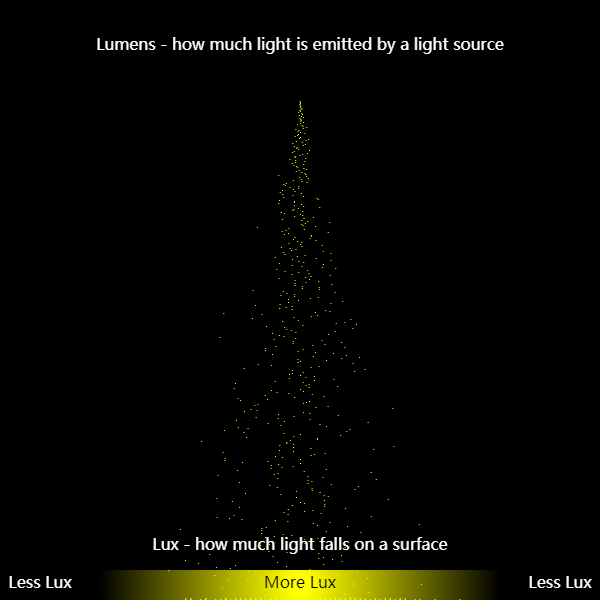We're here to help
Customer Support and Sales Hours
Monday-Thursday 9AM-6PM ET
Friday 9AM-3PM ET
Customer Support and Sales Hours
Monday-Thursday 9AM-6PM ET
Friday 9AM-3PM ET
If you want to
know the brightness of the light bulb, you may see two metrics that may confuse
you - lux and lumens. Both are related to brightness, but the measurements are
slightly different.
In this article,
we will explain the difference between the two and how to understand the
indicator!
The core
differences can be summarized as follows:
Lux is an
indicator of illuminance, and illuminance is the total amount of light falling
on the surface.
Lumens are
measures of luminous flux and are the total amount of light emitted in all
directions.
In the chart, each
yellow dot represents a unit of brightness. Lux is the number of points that
fall on a particular surface, while lumens is the total number of points that
are released from the light source.

The closer to the
light source, the higher the lux reading. This is due to the scattering of
light as it travels away from the source.
Therefore, when
you look at the lux level of a light bulb, you must always ensure the relevant
distance. For example, you might see "1000 lux at 4 feet" - if you
only see the lux level, you won't know the measured distance and you won't be
able to make a valid comparison.
For most
directional sources, such as LED spotlights, the center of the beam typically
has the highest lux reading. When you are farther from the center, the lux will
decrease.
Lux is very
important to understand the brightness of a particular surface. This is a vital
indicator if you want to know how bright the surface is, such as the desktop,
reading material or photography theme.
Without enough lux
levels, it may be difficult to read or take good photos. Common lux levels are
as follows:
Dark, cloudy day:
1,000 lux, or 20 micromoles per second per sq meter
Indirect daylight:
10,000 lux, or 200 micromoles per second per sq meter
Direct daylight:
100,000 lux, or 2,000 micromoles per second per sq meter
Lux is a measure
of the amount of light falling on a particular surface, and may be the result
of multiple bulbs or even daylight mixing.
On the other hand,
lumens are important to understand the amount of light emitted by a single
source. This is useful for comparing the total amount of light emitted by the
bulb, but depending on its light distribution and spatial size, it is not
necessarily certain whether space or task is "sufficient".
Since lux is a
measure of how light falls on a surface, even a small handheld photometer or
spectrometer can measure the amount of light falling on a surface. These are
usually lower costs and can even be connected to a smartphone and used in the
field.
Lumen, on the
other hand, measures the amount of light emitted by a single source and in all
directions. Therefore, a slightly more complicated instrument is required.
Usually a goniosphere or integrating sphere is required. These devices capture
light from all angles and then measure the collective light emitted.
Copyright © 2025 Adiding. All Rights Reserved.
